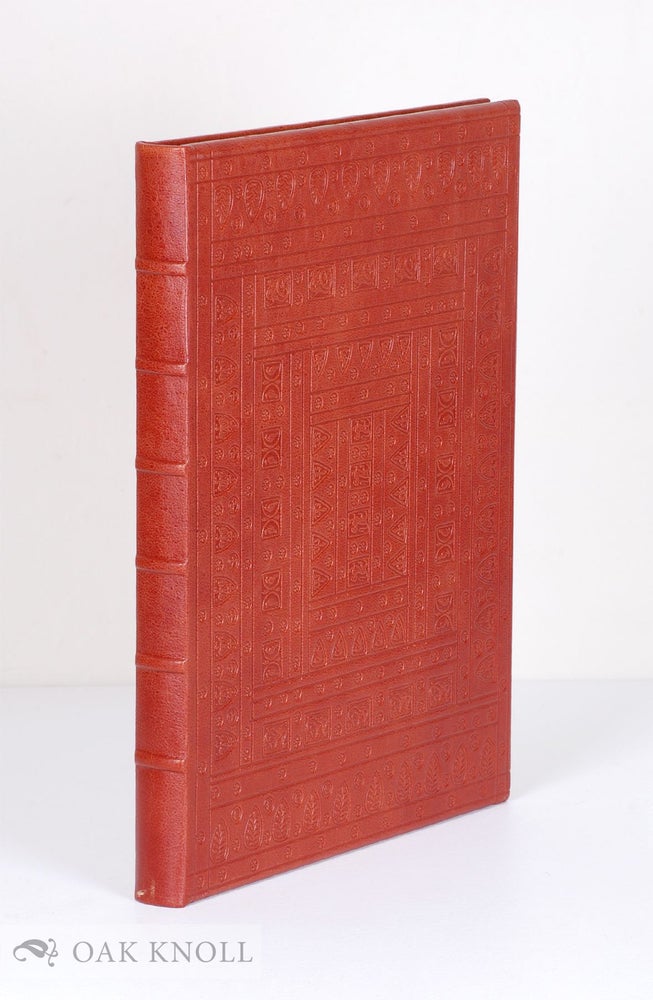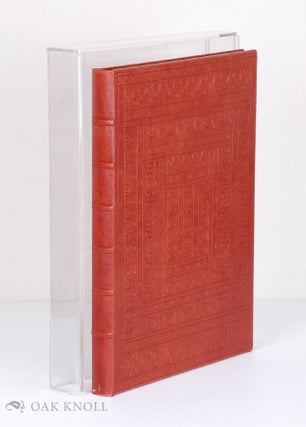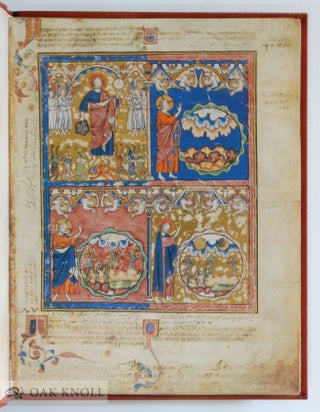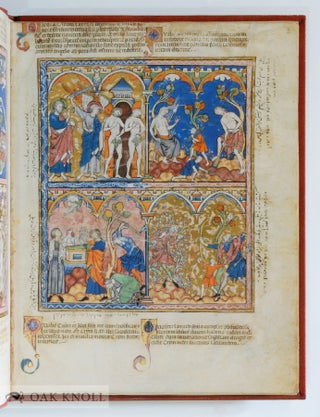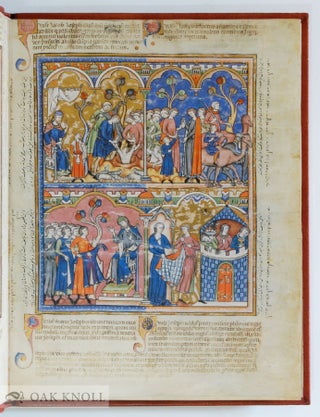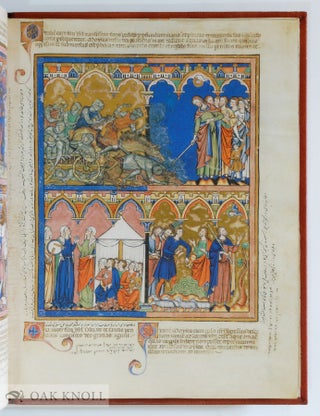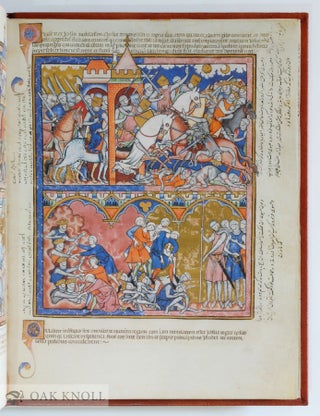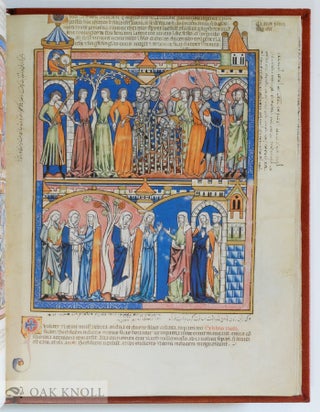LA BIBBIA DEI CROCIATI.
- Rome: Salerno Editrice, 1998.
- folio
- full stamped leather boards, acrylic slipcase
- (92) leaves
- ISBN: 9788884022585
- ISBN: 9788884022585
Price: $5,500.00 other currencies
Order Nr. 137063
Limited to 980 copies, of which this is one of 250 copies reserved for Salerno Editrice in Italian. Lacking the commentary volume. The bottom edge of the slipcase has been separated, but is present. Else in near fine condition.
One of the masterpieces of French Gothic illumination, the Morgan Bible is an impressive reminder of the importance of biblical history for the ideology of the crusade. Also known as the Maciejowki Bible, the Shah Abbas Bible, the Morgan Crusader Bible, and the Morgan Picture Bible, this sumptuous picture book was created in a Parisian workshop for the Capetian king Louis IX in the decade around the Seventh Crusade. Its forty-six leaves, fully illuminated on the recto and verso, feature a vividly expressive Old Testament cycle enriched with abundant use of shimmering gold and costly ultramarine.
Originally devoid of accompanying text, the sacred visual history contained within the Morgan Bible places an emphasis on holy war and kingship and furnishes the Old Testament characters with the armor and weapons of thirteenth-century French Crusaders. By reframing contemporary violence in biblical terms, the visual program offers a powerful justification for Louis IXs departure on his first crusade and protracted Frankish activity in the Holy Land.
The Morgan Bible illustrates selections from the Old Testament, beginning with a Creation cycle and concluding with the life of king David from 2 Samuel. Almost half of the pages are devoted to David, whose identity as a sacred warrior-king was embraced as a model by the Crusader king Louis IX. The cycle ends abruptly, suggesting that a gathering might be missing from the end of the manuscript.
Visual History of Holy War
Composed of 346 individual scenes divided among ninety-two illuminated pages, the Old Testament cycle is one of the most extensive to have been produced in the Middle Ages. The miniatures are skillfully painted with a wealth of naturalistic detail, emotional affect, and finely drawn figures, and luxuriously decorated with gold and ultramarine throughout. Up to seven painters contributed to the illuminations, but the program is consistent throughout.
The book is known for the compelling and naturalistic battle scenes that spill out beyond the border of the pictorial space into the margins; with their attention to gore and technically accurate depictions of armor and weapons, these scenes suggest first-hand observation of the brutalities of war.
Visually and thematically, the Morgan Bible is related to other works made for Louis IX, namely the stained-glass cycles of the Sainte-Chapelle, the Saint Louis Psalter, and the Arsenal Old Testament (Paris, Bibliothèque de lArsenal, MS 5211).
Sacred Stories in Translation
The margins of the manuscript are inscribed with explicative captions in Latin, in Persian, and in Judeo-Persian. The Latin inscriptions are in a fourteenth-century Bolognese script and include gold initials on colored ground. All these much later additions attest to the fascination that the book held for its subsequent owners across religious and cultural divides.
A Series of Illustrious Hands
The Morgan Bible did not remain long in France. The book was in Italy by the early fourteenth century, where it received its Latin captions. At the beginning of the seventeenth century it was in the collection of Bernard Maciejowski, bishop of Cracow, cardinal, and finally primate of the Polish Kingdom; Maciejowski sent the book as a diplomatic gift to Shah Abbas the Great of Persia in 1608, and the Persian captions were added shortly thereafter.
Soon after the manuscript arrived to Isfahan three leaves were removed: two leaves were eventually given to the Bibliothèque nationale de France in Paris in 1891, and the third leaf was purchased by Sydney Cockerel in 1910 and Peter and Irene Ludwig in 1956 before entering the J. Paul Getty Museum collection in Los Angeles in 1983.
In 1722 Isfahan was sacked by Afghan forces, and the Morgan Bible eventually came into the hands of a Persian-speaking Jew who had the Judeo-Persian inscriptions added. Eventually, the book was purchased in Cairo by John dAthanasi and sold at Sothebys in 1833 to book dealers Payne and Foss, who in turn sold it to book collector Sir Thomas Philips.
The Morgan Bible was eventually inherited by Phillips grandson, Thomas Fenwick, who offered it for sale to Belle DaCosta Greene, librarian at the Morgan, in 1916. The first major manuscript purchase of John Pierpont Morgan Jr., the Morgan Bible marked a turning point in the history of the collection.

